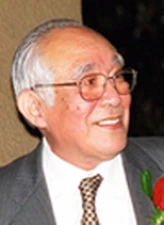Akio Arakawa

The 2010 Vilhelm Bjerknes Medal is awarded to Akio Arakawa in recognition of his pioneering and fundamental contributions to physically based discretisation techniques in atmosphere and ocean models and to representations of convective clouds in atmosphere models, and for his continuing work on bridging the gap between the resolved and unresolved scales in atmospheric general circulation modelling.
The dream of Vilhelm Bjerknes, to solve the basic atmospheric equations mathematically, has been advanced during the last half a century by no one more than by Akio Arakawa. Throughout his career he has identified critical issues and obstacles to progress, and has attacked each of them with great creativity. His beautifully conceived innovations have stood the test of time. Two of his particularly salient contributions are:
- His development of the basic numerical methods that permit atmospheric models to be solved on a computer.
- His prescient identification of the cloud problem and his fundamental contributions to the way that small-scale features such as convective clouds can be represented in atmospheric models that do not explicitly resolve them.
Regarding the first thrust, Arakawa’s contributions to numerical methods began in the earliest days of numerical modelling. They included development of model grids, their relation to computational modes and numerical methods (including the Arakawa Jacobian) for solving the equations on these grids. At that time, it was poorly understood how representation of the continuous equations of fluid mechanics as a system of discrete equations could result in numerical instability. Furthermore, discretisation on different grids could yield different properties, some more desirable than others. Arakawa made fundamental contributions to all of these problem areas that permitted atmospheric modelling to go forward.
Of the many of these Arakawa contributions, his classic 1966 paper on long-term numerical integration of the equations of fluid motion stands out as a milestone known far beyond the field of atmospheric sciences. At that time it was generally thought that non-linear instability was an inherent limitation to longer term atmospheric integrations. Arakawa realized, however, that if a quadratic variable, like kinetic energy, could be conserved in a way similar to its conservation in the continuous fluid equations, a degree of stability was assured.
This monumental 1966 article was followed by many masterful contributions. They dealt with both linear processes, and non-linear processes such as energy and enstrophy exchanges among various scales of motion with the use of special vertical coordinates based on constant entropy surfaces and more. Virtually all atmospheric models throughout the world make use of some of Arakawa’s mathematical methods.
Regarding the second thrust – sometimes referred to as the “physics” in atmospheric modelling – in the late 1960s Arakawa introduced the concept of the cumulus mass flux as a fundamentally important measure of the intensity of cumulus convection on the large scale, a representation that is standard today. This same paper also introduced the idea that convection acts to restore the large-scale temperature and moisture soundings to moist neutrality on a time scale short compared to that characteristic of large-scale circulations. These ideas were greatly refined and generalised in Arakawa’s classic 1974 paper with his student, W. H. Schubert. The depth of this very widely cited work completely overshadows all other studies of its kind. It is undoubtedly the most influential paper ever published on the role of the hydrologic cycle in the general circulation of the atmosphere. Arakawa later published a number of important extensions of these ideas, including his excellent 1987 paper with his student J.-M. Chen, on the closure problem for convective clouds. Many other investigators adopted his approach, so it lies at the heart of the class of parametrisations used for the effects of convective clouds on the larger scale atmospheric systems. Although retired now for roughly 15 years, Arakawa still supervises students and post-doctoral scholars, and is a leading contributor to a U.S. national project on multi-scale modelling of atmospheric processes. His aim is to lay the conceptual and technical basis for a new generation of climate models, ones which unify disparate scales of motions and physical processes in a single underlying framework. In summary, Prof Akio Arakawa’s research career has been characterised by a visionary focus on the key issues of the day, uncompromising vigour, broad scope, and unflagging energy. His research has profoundly influenced all aspects of the crucially important field of atmospheric general circulation modelling. He is regarded within the field as a “living legend”, esteemed, even revered, by all.
